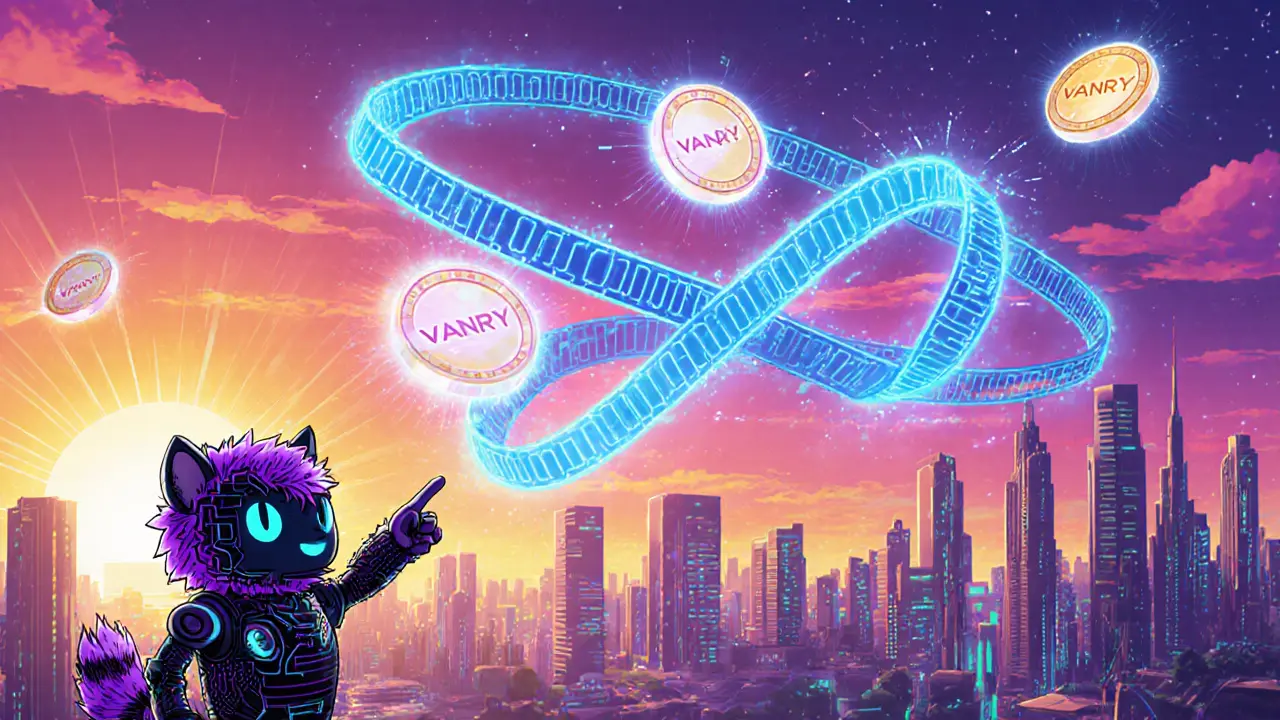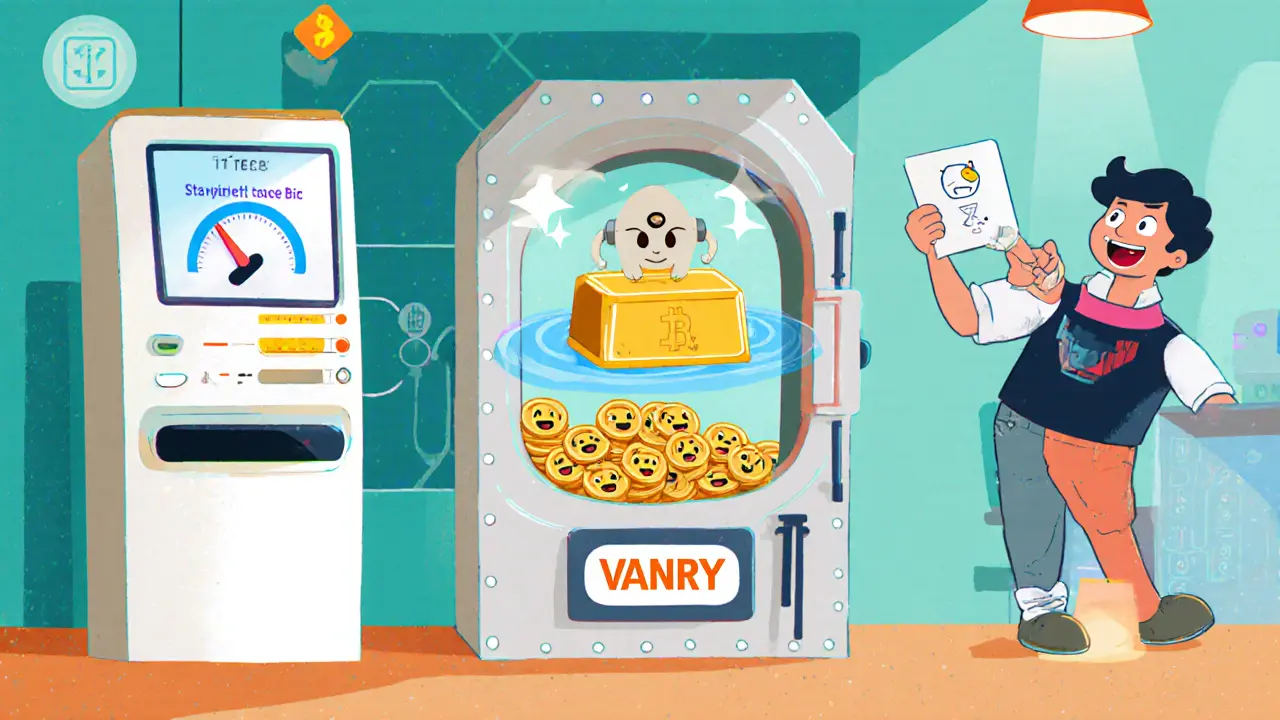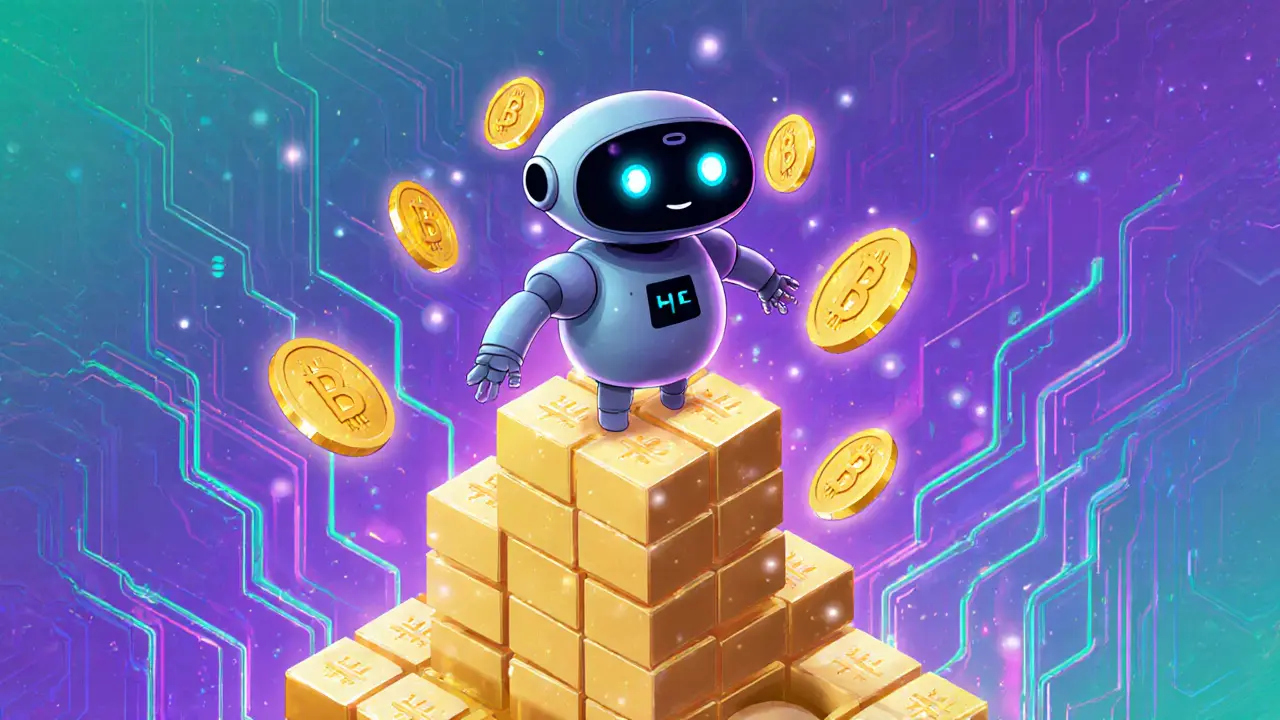
- 27 Sep 2025
- Elara Crowthorne
- 23
Vanar Chain (VANRY) Token Price Tracker
Current Price
Market Cap
24h Volume
Circulating Supply
About VANRY Token
Vanar Chain's native token, VANRY, powers transactions, gas fees, and future governance. With 83% allocated to validator rewards and zero team tokens, it reflects a community-first approach.
The token is used for:
- Paying gas fees
- Accessing AI-enhanced DApp services
- Rewarding validators
- Future on-chain governance voting
Quick Takeaways
- Vanar Chain is the first AI‑native Layer1 blockchain, built for Web3 finance.
- The native VANRY token powers transactions, gas fees, and future governance.
- Its five‑layer architecture embeds on‑chain AI, semantic data compression, and a hybrid PoS/DPoA consensus that can handle thousands of TPS.
- Tokenomics allocate 83% of future supply to validator rewards, 13% to development, and 4% to community programs - with zero team tokens.
- Market cap sits around $55million, price near $0.029, and ranking in the #550‑#560 range (Oct2025).
When you hear the name Vanar Chain is an AI‑native Layer1 blockchain platform that aims to turn ordinary smart contracts into intelligent, self‑learning applications. The ecosystem’s native coin, VANRY, does more than pay for gas - it fuels the on‑chain AI engine, secures the network, and will later give holders a voice in governance.
What is Vanar Chain?
Vanar Chain launched originally as Virtua (ticker TVK) and rebranded in early 2024 with a 1‑to‑1 token swap to VANRY. The rebrand isn’t just a name change; it marks a shift toward integrating artificial intelligence directly into the blockchain’s core. Unlike most platforms that rely on external AI services, Vanar’s architecture embeds AI logic on‑chain, aiming to eliminate the latency, trust, and cost issues of off‑chain computation.
Five‑Layer Architecture - How the AI Integration Works
The platform is organized into five stacked layers, each with a distinct role:
- Base Layer - A scalable, secure foundation built for high‑throughput PoS/DPoA consensus.
- Kayon Layer - The on‑chain AI logic engine (Kayon) that validates transactions, runs compliance checks, and generates predictive insights.
- Neutron Seeds - A semantic compression system (Neutron Seeds) that transforms raw files, legal contracts, and financial statements into compact, queryable AI‑readable objects.
- Intelligent Data Storage - Stores meaning‑based knowledge objects, allowing developers to query data by context rather than hash.
- AI Engine - Learns patterns across stored knowledge and feeds back into Kayon for smarter decision‑making.
This stack lets developers write DApps that can, for example, automatically adjust loan terms based on real‑time risk analysis or verify compliance documents without manual review.

Hybrid Consensus: Speed Meets Security
Vanar uses a hybrid of Proof‑of‑Stake (PoS) and Delegated Proof‑of‑Authority (DPoA). Validators stake VANRY to earn the right to produce blocks, while a smaller set of elected authorities (delegates) handle finality. The result is a network capable of processing several thousand transactions per second (TPS) while keeping decentralization higher than pure DPoA chains.
Tokenomics - Where Does VANRY Go?
The total supply caps at 2.4billion tokens. At launch, 1.2billion were minted to mirror the legacy TVK supply. The remaining 1.2billion will be released over 20years as block rewards:
- 83% for validator incentives - ensures long‑term security.
- 13% earmarked for ongoing development, research, and ecosystem grants.
- 4% reserved for community programs, airdrops, and partnership incentives.
Notably, there is zero allocation for team members, signaling a community‑first approach. Current circulating supply is about 1.99billion, leaving roughly 410million yet to be minted.
Market Snapshot (October2025)
As of the latest data:
- Price: $0.02858-$0.02908 per VANRY.
- 24‑hour volume: $8-$9.5million.
- Market cap: $54.4-$57.1million.
- Ranking: #551‑#564 among all cryptocurrencies.
Price momentum has been modestly positive - a 12.8% gain over the past week and 3% over the month, indicating growing but still speculative interest.
Use Cases - What Can You Build?
Vanar’s AI‑native design opens doors for several practical applications:
- PayFi (Payment Finance) - Real‑time compliant payment processing that can automatically adjust fees based on risk scores.
- Tokenized Real‑World Assets - Securities, property deeds, or commodities can be stored as Neutron Seeds, enabling instant verification and AI‑driven appraisal.
- Regulatory Compliance DApps - Kayon can embed AML/KYC logic directly into smart contracts, reducing the need for off‑chain checks.
- Dynamic NFT Marketplaces - NFTs whose attributes evolve based on AI‑generated trends or user behavior.
These examples illustrate how Vanar moves beyond “code‑only” smart contracts toward systems that learn and adapt.

Getting Started for Developers
Because Vanar is EVM‑compatible, you can start with familiar tools (Remix, Hardhat, Metamask). After deploying a basic contract, you’ll gradually explore the higher layers:
- Set up a Vanar testnet node and obtain test VANRY from the faucet.
- Study the Kayon SDK - it provides APIs for invoking AI logic, submitting compliance queries, and retrieving predictions.
- Learn the Neutron Seeds format - upload a document, then call the “seedify” endpoint to receive a compact seed ID.
- Integrate the Intelligent Data Storage API to query knowledge objects by semantic tags.
- Experiment with the AI Engine by feeding it historical transaction data and observing auto‑generated risk scores.
The official docs (vanarchain.com/docs) include step‑by‑step tutorials, but expect a steeper learning curve than building on Ethereum alone.
Pros, Cons, and Outlook
| Strength | Weakness |
|---|---|
| First AI‑native Layer1, no off‑chain AI dependencies. | Complex five‑layer stack raises developer onboarding hurdles. |
| Hybrid PoS/DPoA consensus delivers high TPS with solid security. | Relatively low market rank limits liquidity and exposure. |
| Community‑centric tokenomics - no team allocations. | AI integration still experimental; real‑world performance unproven at scale. |
| Focus on PayFi and tokenized assets offers clear, revenue‑generating use cases. | Regulatory uncertainty for AI‑driven financial services. |
Analysts believe Vanar could capture a niche of enterprises needing on‑chain compliance and real‑time risk assessment. Success hinges on developer adoption and the maturity of its AI modules.
Frequently Asked Questions
What does the VANRY token do?
VANRY is used to pay gas fees, access AI‑enhanced DApp services, reward validators, and will later enable on‑chain governance voting.
How does Vanar’s AI engine differ from using an off‑chain AI service?
Because the AI logic lives on‑chain (Kayon), results are immutable, auditable, and can be directly referenced by smart contracts without trusting an external API.
Is Vanar Chain compatible with existing Ethereum tools?
Yes. It supports the Ethereum Virtual Machine (EVM), so you can deploy Solidity contracts with Remix, Hardhat, or Truffle just like on Ethereum.
What are Neutron Seeds and why are they important?
Neutron Seeds compress and semantic‑tag raw data (like PDFs or legal contracts) into tiny on‑chain objects that AI can read directly, eliminating broken IPFS links and enabling fast, context‑aware queries.
Where can I buy VANRY?
VANRY is listed on several CEXes and DEXes that support EVM tokens. Check reputable exchanges such as Binance, KuCoin, or Uniswap‑compatible platforms for the latest trading pairs.
Next Steps
If you’re a crypto investor, start by monitoring VANRY’s price action and volume trends while keeping an eye on roadmap milestones (e.g., expanded PayFi features). For developers, spin up a local node, experiment with the Kayon SDK, and consider building a simple compliance‑checker DApp to get hands‑on experience with the five‑layer stack. The community forums on Discord and the official documentation are good places to ask questions and share prototypes.


23 Comments
Great job on diving into Vanar Chain!! The AI‑native approach really stands out!! The zero team allocation shows a strong community focus!! Keep an eye on the validator rewards-they’ll drive long‑term security!! Remember to monitor market‑cap trends as the token gains traction!!
I’ve been following AI‑native blockchains for a while now, and Vanar’s five‑layer architecture is certainly ambitious!! The integration of on‑chain AI with a hybrid PoS/DPoA consensus could address latency issues that plague many projects!! While the market cap is still modest, the 12.8% weekly gain signals growing interest!! It’s also encouraging to see a community‑first tokenomics model with zero team allocation!! For developers, the EVM compatibility lowers the barrier to entry, yet the learning curve for Kayon and Neutron Seeds will require dedicated effort!! Overall, staying updated on roadmap milestones will be key to assessing long‑term viability!!
Wow, another “first AI‑native Layer1” claim – just what the crypto world needed.
Ah, the grand tapestry of blockchain conspiracies unfolds! They say the AI engine is on‑chain, yet who’s to say the hidden “shadow validators” aren’t pulling strings behind the scenes? The colorful promises of semantic compression sound like poetry, but the reality might just be a neon‑lit mirage. Still, it’s fascinating to watch the drama of tokens and trust play out in the Ether‑filled theater.
Vanar’s tokenomics are pretty clear – 83% of future supply goes to validator rewards, which should keep the network secure as it grows. The 13% set aside for development means the project can keep improving without relying on external funding. Community programs get the remaining 4%, giving users a chance to earn a slice of the ecosystem. With a circulating supply of about 1.99 billion, there’s still room for the remaining tokens to be minted over the next two decades. Overall, the model aims to align incentives between validators, developers, and the community.
Looks cool, but honestly, I’m not sold on the whole AI‑on‑chain hype. It’s probably just another buzzword.
Esteemed members of this forum, I wish to convey my profound admiration for the architectural ingenuity manifested within the Vanar Chain protocol. The meticulous stratification into five distinct layers bespeaks a visionary approach to integrating artificial intelligence at the very core of blockchain operations. Moreover, the hybrid PoS/DPoA consensus mechanism heralds a commendable equilibrium between scalability and security, a balance seldom achieved in contemporary distributed ledger technologies. It is incumbent upon us, as discerning observers, to monitor the subsequent developmental milestones with vigilant curiosity.
Yo, did u even read the fine print?? They say “AI native” but i swear there’s a secret code hidden in the docs that only the elites know. Also, the whole validator reward thing might be a trap – think about who’s really pulling the strings behind those nodes. Anyway, cant help but feel like we’re being played like a game of chess.
India needs its own crypto powerhouse, not some foreign AI gimmick – Vanar’s hype is just another Western ploy.
The token distribution appears balanced, with a substantial portion dedicated to validator incentives, which should promote network stability.
Our nation should support projects that boost local tech, not waste time on niche AI chains that might never get mainstream adoption.
From a philosophical standpoint, embedding AI directly into the blockchain could reshape how trust is established in decentralized systems. It invites a new paradigm where smart contracts evolve from static scripts to adaptive agents. While the concept is still nascent, the potential for on‑chain learning may unlock innovative financial products. Observing how the community adopts these tools will be fascinating.
When considering the Vanar protocol, one must evaluate its composability stack, particularly the interplay between the Kayon inference engine and the Neutron Seeds semantic layer. The data pipeline leverages on‑chain vector embeddings, enabling low‑latency query resolution within the consensus boundary. This architecture could significantly reduce the overhead associated with off‑chain oracle calls, thereby optimizing throughput for high‑frequency DeFi applications. Moreover, the hybrid PoS/DPoA consensus presents an intriguing trade‑off between validator decentralization and finality speed, warranting further empirical benchmarking.
Oh my gosh!!! This whole AI‑native thing is just sooo overwhelming!!! I can’t even process how many layers they’ve stacked!!! It’s like a rollercoaster of emotions just reading about semantic compression!!!
Another crypto project promising AI miracles, yet the same old story repeats – hype over substance. The five‑layer model sounds impressive, but where’s the real-world data? Until we see tangible use cases, it remains just another speculative bubble.
Hey everyone!! 🎉 I’m really excited about the potential of Vanar’s AI integration!! It could totally change the game for developers looking to build smarter DApps!! 🙌 Remember to check out the Kayon SDK – it’s a great place to start!! 🚀
Well, if you’re looking for a blockchain that pretends to think, Vanar might just fit the bill.
It will be interesting to see how the market reacts as more projects adopt on‑chain AI.
In the grand tapestry of decentralized innovation, Vanar emerges as a curious paradox-simultaneously austere in its formal tokenomics yet playful in its on‑chain AI aspirations. One cannot help but smile 😊 at the ambition to embed learning mechanisms directly within consensus.
Sure, let’s all trust a blockchain that writes its own poetry while handling payments.
idk why ppl keep hyping this, looks like another fad.
Hey folks, just wanted to say that Vanar’s cross‑border potential could really help bring diverse communities together-definitely worth keeping an eye on.
Wow, this is such an exciting development in the crypto space!! 🎉 The idea of an AI‑native Layer 1 really pushes the boundaries of what we thought possible!! What I love most is the community‑first tokenomics – zero team allocation shows real commitment to decentralization!! The hybrid PoS/DPoA consensus could give us the speed we need without sacrificing security, which is a win‑win!! And the five‑layer architecture? It’s like building a futuristic city on the blockchain, with each layer serving a unique purpose!! For developers, the fact that Vanar is EVM‑compatible lowers the entry barrier, meaning we can start experimenting right away!! The Kayon SDK looks promising – I can already imagine building smarter DApps that adapt in real time!! Plus, the Neutron Seeds concept of compressing data into semantic objects could solve so many storage and retrieval headaches!! Watching the market cap climb while the volume stays healthy is a great sign of growing interest!! I’m also thrilled about the potential use cases like PayFi and tokenized assets – real‑world utility is exactly what we need!! As the token price hovers around $0.029, there’s still room for upside if the roadmap milestones are hit!! Community governance will eventually give holders a voice, adding another layer of empowerment!! Let’s not forget the active Discord community that’s already sharing tutorials and prototypes!! I’m planning to spin up a testnet node this weekend and dive into the AI engine!! 🚀 So, let’s stay optimistic, keep learning, and support each other on this journey!! 🌟